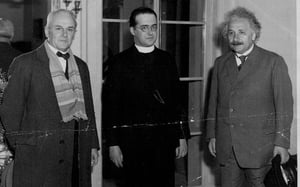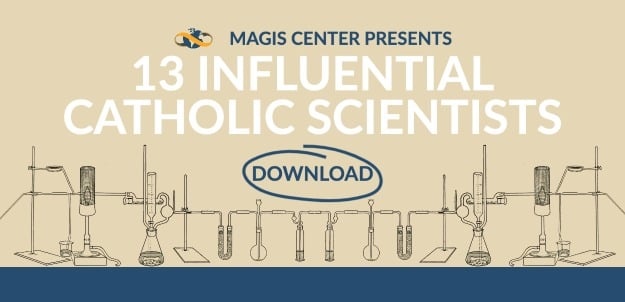“The whole matter of the world must have been present at the beginning, but the story it has to tell may be written step by step.” —Fr. Georges Lemaitre, Nature, 1931
Like the theory of evolution, there is a great deal of misunderstanding of the Big Bang theory and its implications for religious belief. In fact, it might not be an exaggeration to state that many people of faith dismiss the theory as a modernist attempt to write God out of the story of the universe. On the other hand, many cosmologists seek alternate explanations of the observational and mathematical data that make a beginning unavoidable precisely because it looks like a religious idea. As it was when the theory was proposed, so it is now!
In order to dispel both of the above “myths” about the theory, we will give a summary of the state of cosmology at the time of its development and examine the life and faith of the Belgian priest who is commonly recognized as the “Father” of the Big Bang theory, Fr. Georges Lemaitre.
The Stage is Set: Background of the Theory
From ancient times and through the early 20th century, the most common assumption was that the universe was eternal. According to an article in BioLogos, the discovery of radioactivity and the concept of thermodynamic entropy knocked this assumption off its pedestal. It was impossible for the existence of the universe to proceed infinitely backwards in time, precisely because these processes are still going on.
With the discovery of Hubble’s red shift in 1929 came another blow to the static and eternal model of the universe: the experimental confirmation that the universe was expanding. Fr. Lemaitre had anticipated this discovery by his application of Einstein’s equations of the theory of relativity in a 1927 paper (published in English in 1931). The significance of an expanding universe was not lost on Fr. Lemaitre. As startling as the idea of an expanding universe was, Fr. Lemaitre proposed another startling conclusion.
In 1931, in a very short article in the magazine Nature, Fr. Lemaitre mades the following statement:
“Thermodynamical principles from the point of view of quantum theory may be stated as follows: (1) Energy of constant total amount is distributed in discrete quanta. (2) The number of distinct quanta is ever increasing.If we go back in the course of time we must find fewer and fewer quanta, until we find all the energy of the universe packed in a few or even in a unique quantum.” —Fr. Georges Lemaitre [emphasis added]
Lemaitre proposed that this original primeval atom —“the atomic weight of which is the total mass of the universe”—would divide into smaller and smaller atoms by a kind of super-radioactive process. The mechanism he proposed was incorrect, but the theory still holds. According to an article published in the Oxford University Press,
“It was only in the late 1940s that George Gamow and his collaborators Ralph Alpher and Robert Herman independently transformed Lemaître’s spirited hypothesis into a sophisticated model of the early universe. They assumed the initial state to consist of a very hot, compressed mixture of nucleons and photons, thereby introducing the hot Big Bang model.”
The Actor: Who is Fr. Georges Lemaitre?
Born in 1894, in Charleroi, Belgium, Georges Lemaitre came from a devout Catholic family. Apparently, from an early age, not only did he know he wanted to be a priest, but he demonstrated a remarkable talent for mathematics. The family lived in a mining region, so originally, he began studying engineering.
World War I interrupted his life, as it did the life of so many. He spent four years fighting in the Belgian artillery, winning the Belgian War Cross for bravery and service in battle. After returning, he recognized that his real interest was in mathematics and physics, so he switched his educational path. Not only did he enter the seminary at this time—with all the theological studies that entailed—he completed the equivalent of a PhD in Mathematics and became Fr. Lemaitre in 1923.
Cardinal Mercier encouraged the talented priest to pursue his interest in physics and philosophy. It was during this time that Fr. Lemaitre was given a grant to study under Sir Arthur Eddington in England. (In 1919, during a solar eclipse, Eddington made the famous observational proof of the bending of light by the sun. This was one of several predictions of Einstein’s theory of relativity.) Eddington recommended Lemaitre for further studies at Harvard College Observatory with Harlow Shapley. During his time under Shapley, Fr. Lemaitre made a significant contribution:
“[H]e invented a graphical presentation of four properties of a pulsating star. The relationship between luminosity, period, mass, and temperature could be read quickly from this graph, so that if three of the properties were known the fourth could be estimated.”
Lemaitre also used his time to travel to various observatories and universities active in cosmological research in the US and Canada. (For a summary and commentary go to this article.) He made his public debut as a cosmologist in 1925 at the American Physical Society with a paper critical of de Sitter’s model of the universe. After returning to Belgium in 1925, Lemaitre took a teaching post at the University of Louven. The subsequent publication of his 1927 paper and its results were mentioned earlier.
For the rest of his career, from 1935, his research focused on cosmic rays (which he mistakenly thought might be the visible “remnants” of the Big Bang). In 1936, Pius XI asked him to join the newly re-formed Pontifical Academy of Science. He received multiple awards throughout his career, and his contributions to cosmology continued as discussed in several excellent biographies.
The Response to Big Bang Cosmology
Sir Arthur Eddington wrote that he found the idea of a beginning “repugnant,” even though he recognized the significance and validity of his former pupil’s 1927 paper using Einstein’s field equations. Initially, Einstein also resisted, though he became convinced later in a 1933 encounter at CalTech with Hubble and after listening to Lemaitre’s arguments.
Many atheist astronomers resisted Lemaitre’s model of an expanding universe with a finite beginning. They threw their support behind a steady state model—especially atheist astronomer Fred Hoyle. (Hoyle coined the term “big bang” in a 1949 radio show, some say to mock Lemaitre’s theory.) Eventually, most astronomers accepted the validity of the theory—with the exception of Fred Hoyle. In spite of the discovery of cosmic background radiation in 1965 (expected if an initial explosive event had occurred) and other evidence, he doggedly and somewhat controversially held to the steady state model until his death in 2001. Why such strong resistance?
Many scientists today have revived attempts to avoid a “beginning” and have proposed alternative theories. For many, the idea of a beginning still smacks of religion, and it is seen as an attempt at scientific proof of Genesis.
It seems that in 1951, Pope Pius XII made a somewhat similar mistake! Or at least, that is the popular interpretation of the story. At the opening of a meeting of the Pontifical Academy of Science, the Pope gave what has become known as the “Fiat Lux” speech. The Pope appeared to claim that new cosmological theories proved the existence of a creator.
Rightly fearing that the Pope’s remarks would be used by critics to justify the dismissal of his theory, and also recognizing the tenuous nature of scientific theories, Fr. Lemaitre intervened quickly. There is no record of their meeting, but what is known is that the Pope amended his statements when he addressed the International Astronomical Union in 1952. That story is explained and written about here.
Faith and Science
Does the Church need science? Certainly not, the cross and the gospel are sufficient for her. But nothing human is alien to the Christian. How could the Church have failed to take an interest in the most noble of the strictly human occupations: the search for truth? –Georges Lemaître
How did Fr. Lemaitre view his work as a scientist, his vocation, and life of faith? Were they separated as distinct activities? During his career he continued his priestly duties and always appeared in public in clerical clothes. In this article, his deep spirituality is mentioned:
He was part of a small community of priests, the Friends of Jesus, who sought a deeper spirituality through studying mystics, regularly attending silent retreats and taking special vows, such as poverty and a complete offering of their lives to Christ.
Fr. Lemaitre also quite clearly defends the scientific integrity of his theory, in particular, as distinct from his faith:
As far as I can see, such a theory [the Big Bang] remains entirely outside any metaphysical or religious question. It leaves the materialist free to deny any transcendental Being. —Fr. Lemaitre as quoted in M. Godart and M. Heller’s, “Cosmology of Lemaître”
Or as Fr. Lemaitre put it in 1936, “Divine revelation never taught us what we could have found out by ourselves.”
Fr. Lemaitre, however, cannot be accused of seeing two magisteria—faith and science—as having non-overlapping domains. As Bro. Guy Consolmogno remarked in a post for the Vatican Observatory, the intersection of faith and science is in a human person, the scientist himself. Fr. Lemaitre reveals this integrity at the conclusion of a collection of essays published in 1950, “The Primeval Atom”:
“We cannot end this rapid review which we have made together of the most magnificent subject that the human mind may be tempted to explore without being proud of these splendid endeavors of Science in the conquest of the Earth, and also without expressing our gratitude to One Who has said: “I am the Truth,” One Who gave us the mind to understand him and to recognize a glimpse of his glory in our universe which he has so wonderfully adjusted to the mental power with which he has endowed us.” —Georges Lemaître
Later Years
After WWII, Lemaitre lived with his mother and took care of her until she died in 1956. Often his leisure time was spent with his brother Maurice and his many nieces and nephews. He played the piano, enjoyed photography, and studied Chinese. His appointment to the Belgian-Italian cultural exchange commission provided an excellent and enjoyable opportunity for travelling throughout Italy. From 1960 until his death, he served as the President of the Pontifical Academy of Science, of which he had been a member since 1936.
In 1964, Fr. Lemaitre suffered a heart attack which weakened him greatly. Later it was discovered that he had leukemia, but alas, too late! Finally, on June 20, 1966, he leapt past the boundary of space/time into eternity.
A Life Lived to the Full
In a recent documentary on the Big Bang theory, Lemaitre isn’t even mentioned. Perhaps this is because his priesthood and scientific career do not fit the standard narrative of a necessary antagonism between faith and science. The fact that the IAU voted in 2018 to change the name of the “Hubble Law” to the “Hubble-Lemaitre Law” is one of the proofs, however, that the significance of Lemaitre’s contributions to cosmology is not pious wishful thinking.
Fr. Lemaitre’s scientific and personal life is best summed up perhaps in a quote from Paul Dirac, a renowned theoretical physicist himself. He said of Fr. Lemaitre’s scientific contributions:
“The measure of greatness in a scientific idea is the extent to which it stimulates thought and opens up new lines of research. In these respects we must rate Lemaître’s cosmology of the highest caliber.”
Note: Other resources on Fr. Georges Lemaitre include this short video from the European Space Agency (ESA) and this lecture by Prof. Robert Scherrer from Society of Catholic Scientists 2017.



